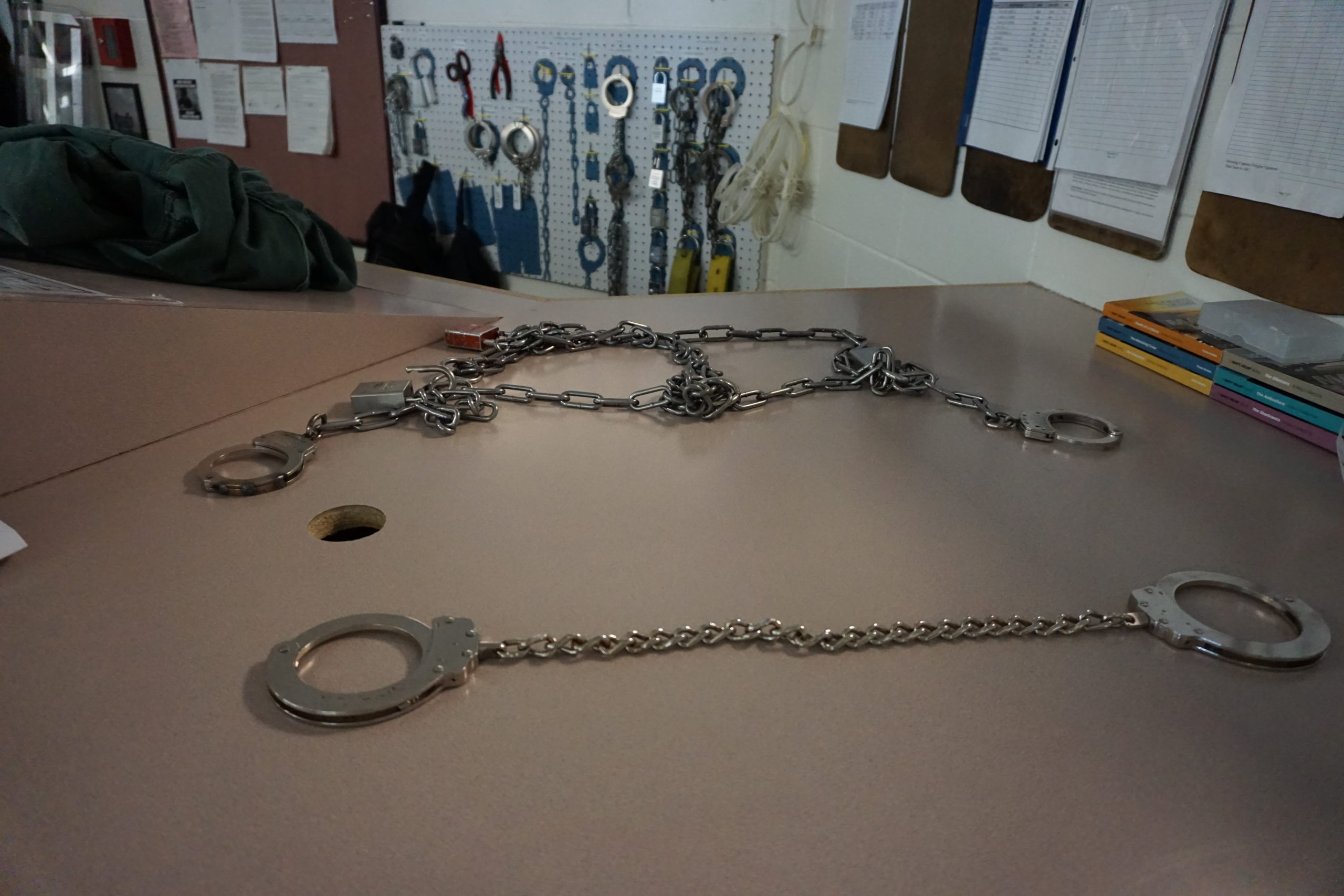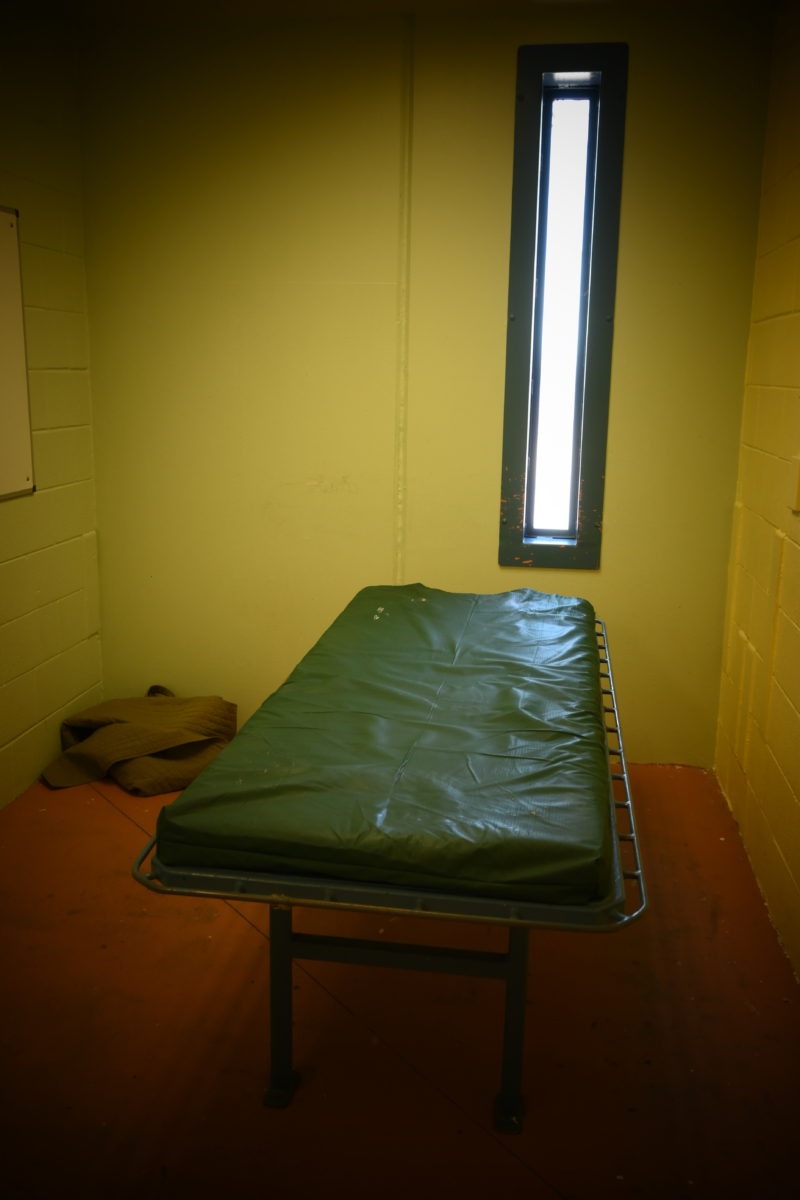Colorado Prisons Hold People in Painful Metal Shackles for Weeks, Report Says
A soon-to-be-released report reveals that metal “four-point” restraints are often used for multiple days in a row, including on one person who was held for 39 straight days. A new state bill would set stricter parameters.

Lindsay lay on her back, restraints pinning her arms and legs to a thin vinyl mattress. It was 2019, she told The Appeal, and she could see a narrow window but nothing beyond it. The cell at San Carlos Correctional Facility in Pueblo, Colorado—a prison designated for those with mental and behavioral health issues—was otherwise bare. She said she’d been placed in the shackles after attempting to hurt herself.
Lindsay, who asked that we use only her first name to protect her privacy, was one of dozens of people in the Colorado prison system held down using painful, metal four-point restraints over the past two years, according to a report released today by the nonprofit legal aid group Disability Law Colorado (DLC). For the report, which The Appeal obtained prior to publication, DLC studied the Colorado Department of Corrections’ (CDOC) use of such restraints in the four facilities where they’re permitted. Between July 2020 and June 2022, DLC found that the CDOC had “a pattern and practice” of using the restraints, deploying them 136 times, including on one person who was strapped to a cot for 39 straight days. Another was shackled in this manner for 90 days over a nine-month period.
In Lindsay’s case, she says she was permitted to get up from the bed only to use the bathroom. Sometimes, a corrections officer would sit her up and free one of her arms to eat; at other times, food was fed to her. Once a day, a mental health provider entered the cell to check on her. When Lindsay asked when she could be taken off the restraints, she says she was told she had to wait until she could be safe. She remained shackled for a week.
“It didn’t help my mental health at all,” Lindsay, now 23 and out of prison, told The Appeal. “You’re really cut off from the world, cut off from your support that keeps you going every day.”
Clinical four-point restraints—so named because they hold down a person’s arms and legs, though they can also include a chest strap and/or belly chain with padlocks—are utilized across the country, ostensibly as protection when individuals threaten to harm themselves or others. Colorado’s system is notable because of its use of agonizing metal restraints, instead of cloth or padded ones. Worse, the state’s publicly available policy sets no limits on how long restraints can be employed and provides no clear criteria for when someone can be released.
On average, DLC’s report said people were restrained for a period of four to seven days during the time period studied. In some cases, shackled individuals were forced to wear adult diapers. Two people were restrained more than 16 times. At San Carlos, 28 people were restrained an average of 3.4 times each.
“It’s horrific,” Meghan Baker, DLC’s facilities team leader, told The Appeal. “What did [CDOC] do between nothing at all and clinical four-point restraints? The answer should be several things.” She has compared the restraint cells to execution chambers and solitary confinement. “In no way does it resemble anything that calls to mind ‘treatment,’” she said.
The American Nurse Journal says four-point restraints should be considered a “last resort” and only used for “as long as [the patient] poses a danger.” The National Commission on Correctional Health Care’s guidelines suggest that people shouldn’t be restrained for more than 12 hours—and not in metal shackles.

DLC’s report comes as the Colorado state legislature is considering a bill to ban the use of metal or hard plastic restraints (as some other states do), require that all other efforts are exhausted before four-point restraints are employed, compel more frequent staff check-ins, and mandate that people cannot be shackled for more than four hours at a time.
State Representative Judy Amabile, the bill’s prime sponsor, told The Appeal that she understands the restraints are “sometimes useful for the person and for the system to have that as an option.” But, she added, its current application feels abusive.
“We’re not meant to be torturing people because they’re sick,” she said.
In an emailed statement, a CDOC spokesperson told The Appeal that individuals on four-point restraints are closely monitored.
“These are not minor mental health issues,” the agency said. “The four-point restraint is only used after all other lower level interventions have been unsuccessful and/or the individual is putting themselves or others at imminent risk, and it is used for the shortest time possible.” CDOC said it is participating in conversations about the state legislation. The CDOC said it could not comment on any imprisoned person’s specific story due to Health Insurance Portability and Accountability Act (HIPAA) regulations.
When Tyler Himelstieb—who has since testified in favor of Amabile’s bill—was transferred to San Carlos, he told The Appeal he arrived with a dangerous coping mechanism: smashing his head against his cell door. The move to a new facility overwhelmed the now 35-year-old Himelstieb, so he banged his head. On July 24, 2020, he was taken to the hospital for stitches and medication. Upon returning to prison, a clinician informed him she was restraining him for being a danger to himself.
“I thought it was going to be four hours or something,” he said. But despite remaining calm, he said “it ended up being approximately 20 hours.”
Himelstieb says he was in pain throughout the ordeal. When the metal cuffs cut into his skin, a nurse applied gauze around his wrists and ankles—and then re-secured the restraints. “I could barely lift my hands above my shoulders because my shoulders were so sore” afterward, he said.
Lindsay, too, says she supports the state legislature’s efforts to reform the practice. She says the longest period for which she was restrained while was incarcerated lasted two weeks. She says she’s so traumatized from her experiences that they continue to impact her health.
“It scares me to want to seek out professional mental health help,” she said. “Sometimes, yeah, I have suicidal thoughts, self-mutilation thoughts, but if I seek out help am I going to be strapped down to a bed?”
